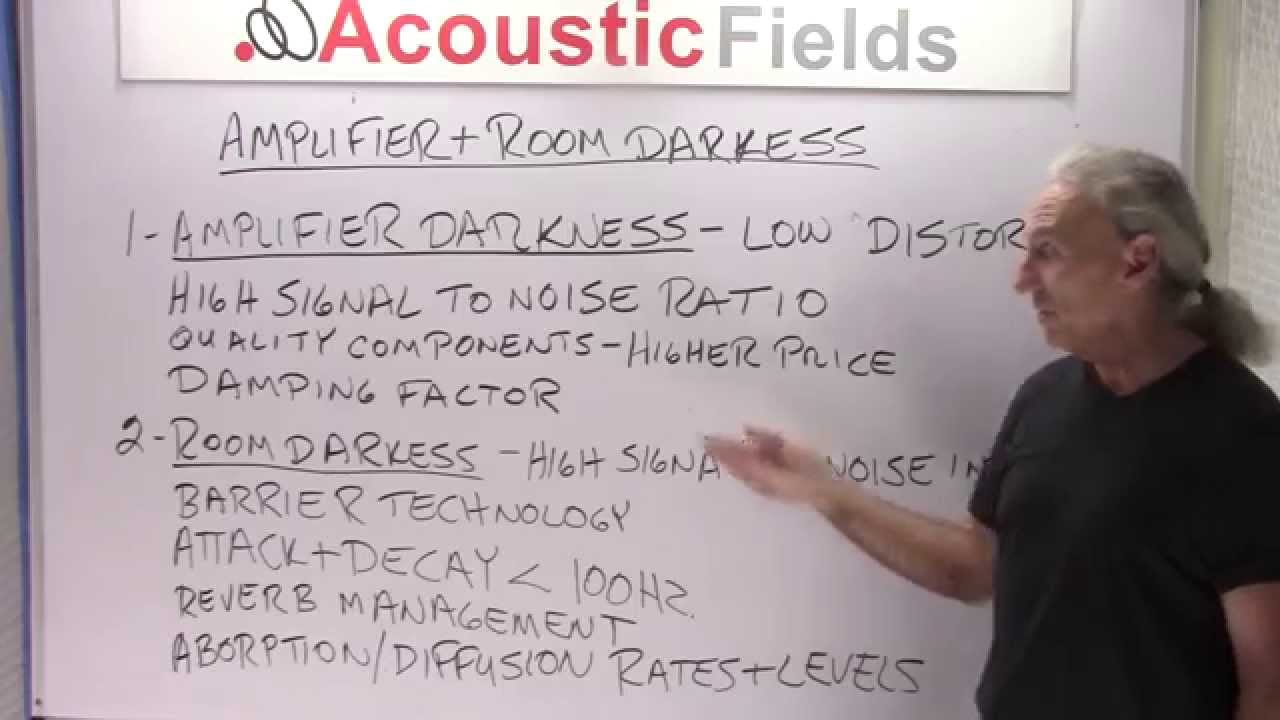The following is an unedited transcript from our video series from Acoustic Fields. There will be some errors in grammar and sentence structure that occur during this translation process.
For complete understanding and comprehension, please view the video which is included in this text. For any additional information regarding this topic or others relating to room acoustics, please contact us directly at:
P: 520 – 392 – 9486
dennis@acousticfields.com
______
Today we’re going to talk about amplifier and room darkness. Not very scientific terms, grant you but nonetheless I think they’ll help illustrate our point. We all know amplifier darkness. Those are the qualities we want in our amplifier, we want them very quiet. We don’t want them creating any noise at all. And if you put your ear up really close to the speaker, sometimes you can hear the background noise levels and have a pretty good idea.
So low distortion is the key to amplifier darkness and the term there. Get a high signal, low noise, so you know, big gaps between signal and noise. So we get them below certain thresholds, maybe even human hearing. So good thing their quality components – your higher priced amplifiers they’re expensive but if you listen to the higher priced ones and the higher quality ones that use the quality components, you can definitely hear the darkness in them. And that’s we all want, we like that distance between each note. We like one note to live and die on its own volition and then the next note start with a little bit of space between or – what we call darkness. So damping factors always in the low frequencies with amplifiers are critical, you have to look at.
What’s room darkness? Pretty similar to amplifier darkness. High signal to noise ratio. We want a lot of music and no noise. And we don’t want any noise from the outside, so we have barrier technology to keep all that noise out and to keep the noise that we’re making – noise in quotes hopefully – within the room and not letting it out to the other area.
So what’s really critical for our room darkness? Attack and decay rates, especially below a 100 hundred cycles. If you don’t get that low end right, you don’t let each note live and die on its own volition and separated and defined, it’s just soup, it’s mud. And you know, that’s no way to have your presentation and your sound stage. So attack and decay below 100 cycles.
Reverb management; must manage those reflections. Side walls are very very critical. Not only do you use absorption. And I see this a lot from my – our customers everyday. They put up absorption on the side walls without understanding what is the rate and level of absorption. And you can’t do that because those sidewall reflections, the primary, secondary and tertiary reflections are really critical to get right. And the absorption rates and levels must be taken into consideration. Reverberation management, we just went over.
Absorption, diffusion rates and levels, you’ve got to – like we said, especially on the sidewalls and all the other surfaces. And that just contributes to the correct RT 60 times that you are after. So you try and get your room down to a low and a high with reverb and then subjectively find that magic spot for yourself and your usage within the room.
So I hope this helps. The amplifier darkness, room darkness, kind of the same, little bit of similarity, I hope the definition helps but it’s all about each note being heard regardless of frequency, defined, living and dying on its own volition, the fundamental and the harmonic and the second and third order harmonic after that, each one has to to be defined. That’s where the emotion is. That’s what we’re after. That’s what we’re trying to connect to in our music.
Thank you,
Dennis Foley







